 Both the Spanish and Portuguese brought Chilis back
from the New World, but from different regions, and they used them quite
differently. The Spanish brought Chilis from Central America and
Mexico, and set about developing mild chili varieties. The Portuguese
brought Chilis from Brazil, where the hottest chilis had their origin.
Portuguese sailors inflicted hot and super-hot chilis on nearly the
entire world. The world loved them, and set about developing endless
new varieties unique to their own cuisines.
Photo of Portuguese Caravel © Navy of Brazil.
Both the Spanish and Portuguese brought Chilis back
from the New World, but from different regions, and they used them quite
differently. The Spanish brought Chilis from Central America and
Mexico, and set about developing mild chili varieties. The Portuguese
brought Chilis from Brazil, where the hottest chilis had their origin.
Portuguese sailors inflicted hot and super-hot chilis on nearly the
entire world. The world loved them, and set about developing endless
new varieties unique to their own cuisines.
Photo of Portuguese Caravel © Navy of Brazil.
European Chilis are mostly derived from Spanish types, except in Portugal and Holland. Chilis were carried to Hungary by the Turks. These tended to be of moderate heat, as are Turkish chilis today, so they probably acquired them from the Spanish rather than the Portuguese. The Greeks probably got their chilis from the Turks, and the Italians from the Spanish. Spain continues to grow far more varieties of Chilis than the rest of Europe. The Dutch brought back fairly hot chilis from their East India colonies (Indonesia), who had gotten them from the Portuguese.
More on Chili Peppers.
This page features European Chilis that are significant in their particular cuisines, and available in North America. There are hundred, or even thousands more of local significance.
 [Capsicum (British); Shimla mirch (India); Prik Pasom Sot (Thai);
C. annuum var. grossum]
[Capsicum (British); Shimla mirch (India); Prik Pasom Sot (Thai);
C. annuum var. grossum]
Green when unripe, red, yellow, orange, purple, white, pink, etc. when ripe. These are always sold fresh, and are only dried for use as industrial food additives. Box shaped to heart shaped, these large (up to 5 inches across) chilis feature thick, crisp and flavorful flesh with no heat (H0), making them popular in nearly every cuisine worldwide, including all European cuisines.
Wikipedia says the Bell Pepper originated in Szeged, Hungary in the
1920s, and the USDA records the first commercial crop in the
southeastern USA in 1925. On the other hand, Lionel Wafer wrote in
1699, "Bell pepper is a large, fleshy mild green pepper, turning into
red or gold when fully ripe". Further, Thomas Jefferson record receiving
Bell Pepper seeds from Mexico in 1824, and the Boston Cooking School
Cookbook of 1896 has a recipe for "Stuffed Peppers" calling for "6
green peppers". Proportions given suggest Bell peppers. In these peppers,
the gene for producing capsaicin is replaced by a recessive form, so they
lack the sting of other chilis.

[Capsicum (British), C. annuum]
This Bell Pepper was discovered in the Netherlands. It is now marketed in
North America by Sunset as tropical "Aloha Pepper", even though it has
nothing whatever to do with Hawaii or the tropics. Surprisingly, they taste
just like Bell Peppers, and with heat (
H0). They can be eaten raw or cooked, and do retain their stripes
when cooked.
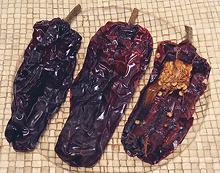 [Guernika, Gernika, Cuerno de Cabra (Basque);
C. annuum]
[Guernika, Gernika, Cuerno de Cabra (Basque);
C. annuum]
This Chili is extremely popular in the Basque Country of the far north of Spain. Great festoons of them are hung up in Basque households to dry. They are very non-hot at H0-H1. These peppers come in several shapes, some of which are narrow, very pointy and up to 8 inches long. The photo specimens are a variety where the point is tucked back into the inside. They were up to 5.5 inches long by 1-3/4 inch diameter (14 x 4.5 cm).
Unlike the Espelette Pepper from the French side of the border, they dry
very wrinkly, and are most often dried. To use them they are soaked well,
until the skins are fairly smooth.The flesh is then scraped from the skins,
which can be done with a metal teaspoon. The taste is sweet, and with a hint
of sun dried tomato. An essential use for these peppers is as a flavoring
in Spanish Chroso sausages.
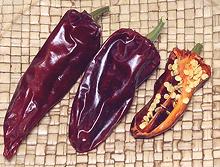 [Basque Pepper; Piment d'Espelette (France); Ezpeletako Biperra (Basque);
C. annuum]
[Basque Pepper; Piment d'Espelette (France); Ezpeletako Biperra (Basque);
C. annuum]
This extremely popular Chili is grown in the the French Basque country,
in towns tightly clustered in the far southwest corner of France, just
above the Spanish border. Great festoons of them are hung up in Basque
households to dry. They are smoky/fruity in flavor and moderately hot
at H5. They are AOC (France) and PDO
(Europe) protected in 10 towns. Due to the PDO (2002), they cannot be called
"Espelette" if grown outside that tiny region. Some Non-PDO peppers are
grown in California and Idaho. The photo specimens were up to 4 inches long
and 1-1/8 inch diameter (10x3 cm), grown in Idaho and sold as "Basque Pepper".
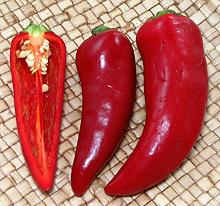 ["Red Jalapeno" (U.S. supermarkets); C. annuum]
["Red Jalapeno" (U.S. supermarkets); C. annuum]
This is the chili chosen by all ethnicities in Southern California as
the medium hot fresh red chili suitable for their cuisines - and I
have recently seen them listed in European chili lists, so make no
apologies for including them here. They are about hotness
H4-5. Core and seed them, but
leave in the membranes (where the heat is) if you want some heat. With
the membranes carefully removed they have little heat. They have good
flavor, and the walls are quite thick, so they are not dried. For details
see our Fresno Chili page.
 While these pickled chilis from Spain superficially resemble Italian
Peperoncini, except for being much longer and
thinner, the resemblance is just that, superficial. These have much
better flavor and some nice, but not overwhelming, chili heat. Definitely
superior, they are more appropriate as appetizers than as sandwich
ingredients. The big one at the top was 6 inches long (not counting the
stem) and 0.50 inch diameter at the big end. Available from some purveyors
of Spanish foods.
While these pickled chilis from Spain superficially resemble Italian
Peperoncini, except for being much longer and
thinner, the resemblance is just that, superficial. These have much
better flavor and some nice, but not overwhelming, chili heat. Definitely
superior, they are more appropriate as appetizers than as sandwich
ingredients. The big one at the top was 6 inches long (not counting the
stem) and 0.50 inch diameter at the big end. Available from some purveyors
of Spanish foods.
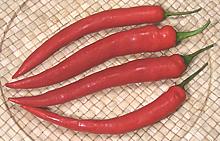 [Dutch Red, Cabai Merah (Indonesia); C. annuum]
[Dutch Red, Cabai Merah (Indonesia); C. annuum]
A cayenne type pepper sold fresh and red ripe. They are 4 to 6 inches long
by 5/8 inch diameter and tapered to a sharp point, hotness
H4-H5. They have thicker flesh
than some long narrow chilis and sweet taste. These are popular in
Holland and its former colonies in Indonesia as well as other parts of
Europe and California. Probably would be about right for Sichuan and
Hunan recipes and are a good choice for most ethnic cuisines.
Fresnos are a good substitute, though of
different shape and thicker walled, and are much more readily available
here in California.
 [C. annuum]
[C. annuum]
These yellow-green chilis have medium thick walls with crunchy texture
and little or no heat (H0 - H1).
The center photo specimen was 5-7/8 inches long, 2-1/8 inches across and
weighed 4-1/4 ounces. Allowed to fully ripen they become bright
red-orange.
Details and Cooking.
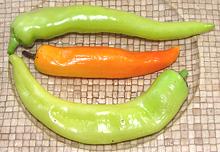 [C. annuum]
[C. annuum]
These long, medium hot chilis, tapering to a slightly rounded tip, are
sold fresh when yellow green. They have fairly thin walls and hotness is
usually H4,H5. They are
extensively used in European cuisines, particularly that of Hungary.
Allowed to fully ripen, they become orange-red. The largest of the photo
specimens was 7-3/4 inches long, 1.2 inches diameter at the big end and
weighed 1-5/8 ounces.
 [C. annuum]
[C. annuum]
This Chili is said to have been brought from southern Italy in 1887,
and is now very much favored in Puerto Rico, the Dominican Republic
and Cuba, but also used in many other cuisines where a thin walled,
thin skinned very mild chili is wanted. Interestingly, I have never
seen these in Southern California, where the type is represented by
Hungarian and Armenian / Turkish peppers. These Chilis are usually
very mild, solidly within hotness
H1, but they can occasionally get to the high end of
H2. They are usually harvested
while still yellow-green, but turn bright red if allowed to ripen. They
have rather thin walls and grow to about 6 inches.
Subst: preferably the very low heat Hungarian or Armenian /
Turkish chilis. Anaheims are second choice (thicker walls, more intense
flavor, usually a little hotter) and green bell peppers are a distant
third (very thick walls, different flavor). Photo
by United States Department of Agriculture = public domain.
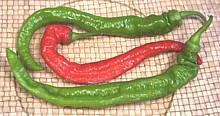 [C. annuum]
[C. annuum]
Fresh green, 2 to 7 inches long by 3/4 inch in diameter,
H0-H2
and easily recognizable by their wrinkly tops. They come in two varieties,
smooth and wrinkled. They are fine for munching on or using in salads or
Italian recipes. Red ones are sweeter but not nearly as available
as green.
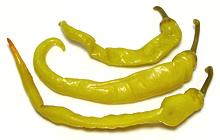 [C. annuum]
[C. annuum]
These Italian peppers are pickled in the same way as
Peperoncini, but have no heat whatever, making them
comparatively rather dull and uninteresting. In my opinion, not worth
the price. The longest in the photo was 7.5 inches long and 0.65 inch
diameter.
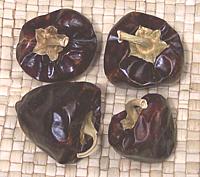 [Choricero; C. annuum]
[Choricero; C. annuum]
A small heart shaped dried sweet pepper about 1-5/8 inch diameter or smaller. It's very important to much Spanish cooking, particularly from the Basque region. It's quite sweet with almost no hotness and can be had from Spanish emporiums in the U.S. at a stunning $3.50 per ounce or so. Cascabels look similar but have a thinner, much less sweet flavor and more hotness.
My formula for a substitute for Nora Peppers is this: 3 parts California
Chilis, 2 parts Ancho Chilis and about 1/8 teaspoon of Lemon Juice for each
chili used - Noras have a definite sour tang to them. This mix is a shade
darker in flavor and has a little more heat than real Noras but it's
reasonably close.
 [Pimientos de Padrón (Spain); C.annuum]
[Pimientos de Padrón (Spain); C.annuum]
From the concello of Padrón in the northwest corner of Spain,
these peppers are wrinkly in shape and erratic in heat. The saying is,
"Padrón Peppers, some are hot, some are not". Those in the photo
were grown in Southern California and were just a little hot. The largest
was 2-3/4 inches long and 1-1/2 inches diameter. In weight they ran from
about 1/2 ounce to 1-1/4 ounces. Subst: The
Japanese Shishito Chili is
an excellent substitute.
Details and Cooking.
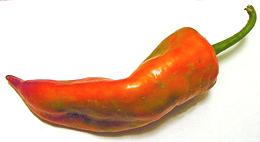 [C. annuum]
[C. annuum]
Medium size pointy pods of this sort (6 to 8 inches long and 1-1/2 inches
wide) are allowed to ripen fully, then dried and ground into Paprika
powder in Hungary (American paprika is made from dried Anaheim type pods).
Originally all Hungarian paprika was hot, but non-hot versions were
desired by neighboring countries. A mild variety was discovered, and now
dominates production. The Hungarians say their Chilis came from China,
but they were brought by invading Turks, who probably got them from
the Portuguese through India, not China. In any case paprika chilis
were being planted in private gardens in Hungary by 1569.
Photo by Josip Rodin
distributed under GNU
General Public License v3.
 [Peperoni, Friggitelli (Italy); Greek Peppers, Peperoncini (American
English); C. annuum]
[Peperoni, Friggitelli (Italy); Greek Peppers, Peperoncini (American
English); C. annuum]
Pickled peperoncini are a mainstay of sandwich making and are often used
in salads, particularly Greek salads. They are very seldom seen in North
America except in pickled form, as in the photo. Greek varieties (the
photo specimens were from Greece) are reputed to be sweeter than the
Italian. They are picked fairly small, typically 2-1/2 inches long by
1-1/4 inches across, and they are rather mild
(H1). In Italy the name
"peperoncini" is not used for these but only for hotter chilis.
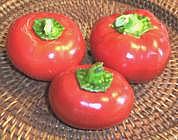 [C. annuum]
[C. annuum]
Red ripe, round or heart shaped to 4 inches in diameter with thick walls
making them substantial and attractive for food processing uses where
appearance is a factor. Hotness
H0, they are very tasty and sweet, similar in flavor to red
bells but more intense. Unfortunately they are seldom seen in stores
in the US.
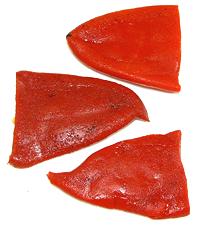
["Little Beak"; C. annuum]
Red ripe pimento type peppers grown around Lodosa in the Spanish state of Navarra and strictly regulated by Denominacion de Origen. They are flame roasted over open wood fires, seeded and peeled by hand and put up in jars and cans. Spanish chefs who otherwise would never consider something from a can to be edible dote over these. Similar peppers are grown and similarly prepared in Peru.
Piquillos are often stuffed and served as tapas. They have very low
heat (H0) and are very tasty
and sweet. Fresh they look like a Fresno chili, but lack the heat. As
canned they measure about 2-1/2 inches long and 2-1/4 inches across.
They can be ordered from Spanish import emporiums or from various
on-line sources.
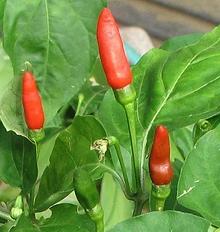 [Piri Piri, Peri Peri, etc. (Portugal, Africa); C. frutescens]
[Piri Piri, Peri Peri, etc. (Portugal, Africa); C. frutescens]
Up to 2 inches long, these are standard bird chilis. Larger ones are
called Malagueta in Brazil and Portugal, smaller ones are called Piri Piri
in Portugal and Malagueta in Brazil. They are pretty much identical to the
Piri Piri chilis of Africa, because those were brought to Africa by the
Portuguese. They are quite hot at
(H9). Subst: Thai Chilis, not as
hot but much more available. Caution: many food
writers have fallen afoul of confusion between Malagueta Peppers and
Melegueta Pepper, a spice seed in the Ginger family also known as
Grains of Paradise.
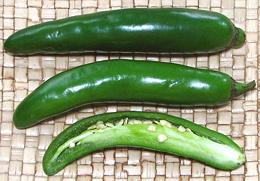 [C. annuum]
[C. annuum]
Native to the mountains of Mexico, these are NOT a European chili, but they should be. They are available everywhere in the Americas, have been enthusiastically adopted in Thailand and are spreading to other parts of Asia. Here in North America, they are the "go-to" for fresh hot green chilis when chilis native to a particular cuisine are not available.
These have more flavor than most hot green chilis - but nobody seems
to be complaining. They are fairly hot (about
H6), but the heat can be much
reduced if necessary, by removing the seed mass and membranes. They are
usually used green with the seeds in. They can be up to 4.5 inches
(11.5 cm) long and 0.8 inch (2 cm) diameter. The flesh is fairly thick,
so they are not dried.
 Even the Europeans can't get along without a touch of hot chilis. Fairly
hot at around H8, usually
without much flavor, Cayenne is the "standard" for adding heat to recipes
without greatly affecting the flavor. Sometimes it's made from actual
Cayenne chilis but often not. It varies in color and is often of a duller
and less red color than the version in the photo which was made by one of
the big Mexican chili companies.
Even the Europeans can't get along without a touch of hot chilis. Fairly
hot at around H8, usually
without much flavor, Cayenne is the "standard" for adding heat to recipes
without greatly affecting the flavor. Sometimes it's made from actual
Cayenne chilis but often not. It varies in color and is often of a duller
and less red color than the version in the photo which was made by one of
the big Mexican chili companies.
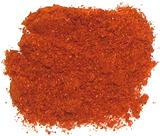
Hungarian paprika is flavorful and brilliant red. "Sweet" (H0) and "Hot" (H2) versions are sold. Today, when a recipe calls for "paprika" it means sweet - hot is used mainly as a "sprinkle" at serving, but originally all Hungarian paprika was hot.
Though now the signature spice of Hungarian cooking, paprika was little
used until after 1850. It is said the technique for grinding chilis into
fine powder was first developed in Hungary.
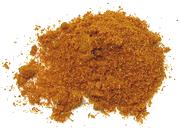
Spanish paprika is made from an entirely different chili than the
Hungarian, coming directly from the New World rather than through Turkey,
and it has a different flavor. It comes in several versions, including
Dulce (Sweet), Agridulce (bittersweet) Picante (Hot, about
(H3)), Ahumado (Smoked, about
(H2)). Hungarian paprikas are
reasonable substitutes for Dulce and Picante, but the others are unique
to Spain.